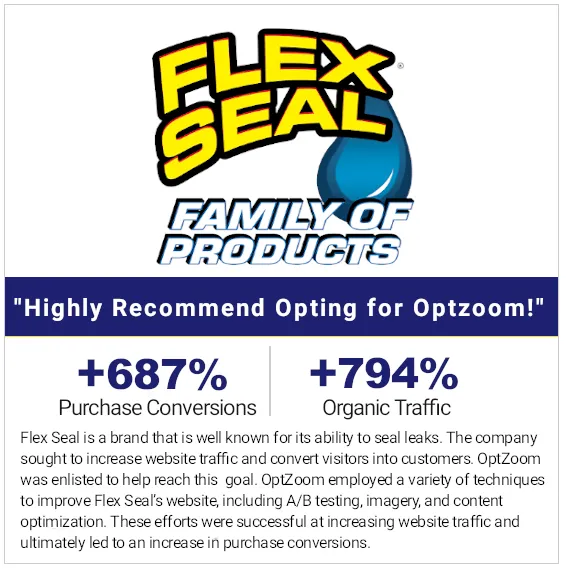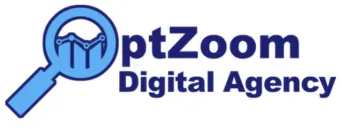Turbocharge Your Marketing with OptZoom
OptZoom offers a comprehensive range of services with a strong focus on delivering results. Our performance-based technological approach, backed by behavioral science, prioritizes helping clients achieve optimal ROI.


Industries We Serve
Optzoom.com serves a wide range of industries, contingent to the diverse needs of businesses across various sectors. From e-commerce and retail to healthcare and technology, Optzoom.com understands the unique requirements of each industry. Our services encompass website development, digital marketing, content creation, and search engine optimization (SEO), among others. Whether you are a small start-up or an established enterprise, our team of experts is equipped to deliver tailored solutions that drive growth, enhance brand visibility, and maximize your online presence. With a deep understanding of industry trends and a commitment to excellence, Optzoom.com is dedicated to helping businesses thrive in today's competitive marketplace.

Automotive
Beauty & Fashion
Business Consulting
Creative
Financial
Health & Wellness
Home Services
Legal
Medical
Real Estate
Restaurant
Travel & Hospitality
Recent Clients


Our Services
Digital Marketing Management
OptZoom.com is here to take your company's digital marketing to the next level! With our expert team of professionals, we have the knowledge and skills to help your business thrive in the online world. Whether it's creating a captivating website, crafting engaging social media campaigns, or optimizing your search engine presence, we've got you covered.



Website Management
OptZoom.com is an excellent resource that can greatly assist your company with its Website Design & Management needs. With a team of skilled professionals, OptZoom.com offers comprehensive services aimed at enhancing your online presence and driving success for your business. Whether you are starting from scratch or looking to revamp your existing website, OptZoom.com can create a visually appealing and user-friendly website that aligns with your brand identity and business goals.

Social Media Management

OptZoom.com is your ultimate solution for effective and efficient social media management. With our innovative platform and expert team, we can take your company's social media presence to the next level Our comprehensive suite of tools allows you to effortlessly schedule and publish posts across multiple social media platforms, saving you time and ensuring consistent messaging. We also provide advanced analytics that give you valuable insights into the performance of your social media campaigns, helping you make data-driven decisions to enhance engagement and drive results.

Reputation Management

OptZoom.com Digital Marketing is your go-to solution for effective reputation management. Our expert team understands the importance of maintaining a positive online image, and we have the knowledge and tools to help you achieve just that. We will work closely with you to monitor, manage, and improve your online reputation across various platforms. Whether it's addressing negative reviews, managing social media presence, or implementing proactive strategies to enhance your brand's image, OptZoom.com Digital Marketing has got you covered.

Ecommerce Management

OptZoom.com Digital Marketing offers comprehensive eCommerce management services that can greatly benefit your business. With our expertise, we can optimize your online store to increase visibility and drive more traffic to your website. Our team of professionals will work closely with you to develop effective marketing strategies, including search engine optimization (SEO), social media marketing, and pay-per-click (PPC) advertising.


Lead Management
OptZoom.com Digital Marketing can greatly assist with lead management for your company. With our expertise in digital marketing strategies, we can help you efficiently capture, track, and nurture leads throughout the entire customer journey. Our team of professionals will work closely with you to develop a comprehensive lead management strategy tailored to your specific business goals and target audience.
Our 3-Step Process
Step 1
We Build Your Web Presence
Experience the benefits of our expertise by allowing us to craft a website or splash page OPTIMIZED for maximum conversions. Our TAILORED solutions are designed to showcase your unique business while driving RESULTS and boosting your online presence. Let us take care of building your digital presence so you can focus on what matters most – GROWING your business.
Step 2
We Schedule Your Leads
Sit back and RELAX while we take care of scheduling your lead appointments. Our efficient system handles everything for you, from setting up the appointments to sending timely reminders. With our assistance, you can EFFORTLESSY manage your calendar and ensure that no appointments are missed.
Step 3
We Nurture Your Leads
We prioritize STRENGTHENING communication with leads to increase the likelihood of your customers returning time and time again. By making a positive connection, we not only ENCOURAGE them to leave GLOWING reviews but also inspire them to spread the word to their friends and acquaintances.
Questions?
Schedule A Free Consultation
or send us a message below
CONTACT ME, TROY "THE SUPER TECH BOY"

Owner/Operator | Consultant
With over two decades of expertise in web marketing and development, I’m your go-to professional.
Whether I'm driving your bottom line or crafting data-driven strategies to expand your brand’s reach, I’m your dedicated point of contact for all your web marketing needs.
I drive growth by maximizing conversions through integrated web design, development, and marketing strategies. I create digital experiences that attract, capture, and retain customers, transforming your online presence into a results-driven engine.
In my free time, I enjoy spending time with my 6-year-old daughter, watching sports, riding my e-bike, and staying up to date with the latest technological trends.

Call/Message
Visit
8910 SW 172 Ave
Miami, Florida 33196
Contact Us
We're happy to hear from you!
OptZoom.com
Technology Excellence Since 1999
© Copyright 2025. OptZoom LLC. All rights reserved.
Zoom Ahead With OptZoom!




